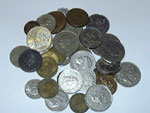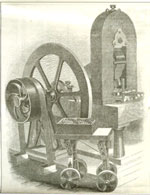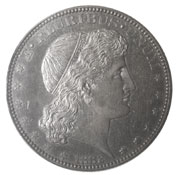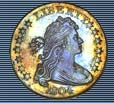|
|
 |
 |
|
 |
| |
In general, coins can generally be classified as U.S., World,
or as Ancient coins. There also exists numerous medals, tokens,
coin books and exonumia, or those items such as coin buttons,
glass with coin images, counterstampled coins, post cards with
coin images etc., all of which are related to numismatics. Sometimes
just figuring out what you even have can be a daunting task.
|
|
 |
| |
|
|
 |
 |
 |
 |
|
To make
matters more complicated, early coinage prior to 1836 in the
U.S., required hand engraving and hand punching of design elements
in both the obverse and reverse dies. The coins that resulted
from these die pairs may have significant differences from one
another and can be termed die varieties. In
more modern coins, obverse and reverse die pairs were hand engraved,
reduced and made into a master hub. These, in turn, were transferred
to produce a number of working hubs, and consequently were impressed
into many working dies. These working dies may have struck up
to hundreds of thousands of coins before die wear or fatigue
forced them into retirement. |
 |
 |
 |
In some
cases a die would break early in its mintage due to the extreme
pressure of striking. It would be replaced by another die, thus
creating a coin with a different obverse and reverse die pair.
These are referred to as specific die marriages. In addition,
Mint engravers made mistakes while working on dies. That’s
why today we can distinguish between coins that have a doubled
die (or triple, or multiple punched die), an overdate, a repunched
mintmark, a repunched date, a misplaced date, “micro”,
oval or huge mintmarks, and doubled reeding to name a few.
|
|
|
| |
|
|
 |
 |
 |
|
|
| |
|
|
| |
|
|
| |

|
|
Some coins
were specially struck as patterns, while others were specially
struck for collectors as proofs. These coins generally have
deeply reflective mirrors in the fields that may contrast from
frosty cameo devices on the coin. However, some coins were struck
as a proof with a matte finish. This gives a very different
look than most collectors know as modern brilliant proof coins.
|
 |
 |
 |
Some
coins are beautifully toned and have added eye appeal and consequently
added value to collectors, while others may have negative eye
appeal and lower value.
|
|
|
 |
 |
 |
|
For more modern coins, designations such as Full Steps (Jefferson
nickels), Full Spit Bands (Mercury Dimes), Full Torch (Roosevelt
dimes) Full Head (Standing Liberty Quarters), and Full Bell
Lines (Franklin Halves) may be used to indicate more desirable
coins which are more fully struck and more valuable. Copper
coins may have smooth or pourous surfaces, or may be brown,
red brown, or red in color which impacts on their grade and
value. They may be scudzy, average or choice for the grade.
This could have a substantial impact on their value.
|
 |
 |
 |
|
|
| |
|
|
 |
 |
 |
|





